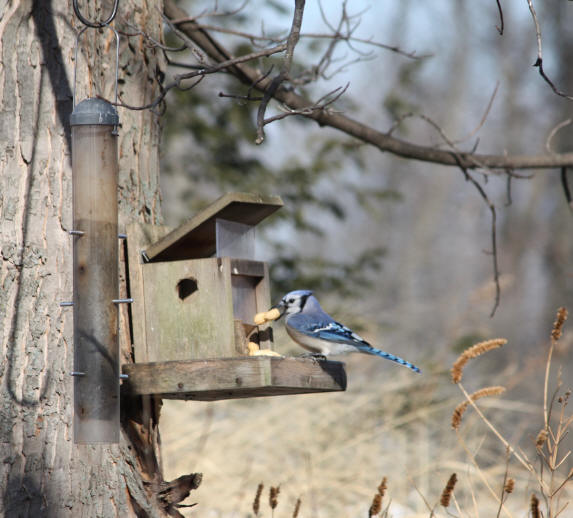Jim Gallion
Frederick County Master Gardener
 Here are some tips that we use in our habitat here in Walkersville and recommended by the National Wildlife Federation.
Here are some tips that we use in our habitat here in Walkersville and recommended by the National Wildlife Federation.
Winter is arriving and cold snowy or rainy days are in the forecast for the Mid-Atlantic region over the next several months. Now is the time to assess our backyard gardens to see how wildlife-friendly they are - or could be - with a little human
help. By providing food, water, cover, and places for wildlife to raise their young, backyard gardeners can make a difference, even during the cold winter months.
Most animals put off giving birth and raising young until spring. In winter, they are looking for high-energy food, reliable water sources for drinking and bathing, and places to find cover from predators and from winter weather. Winter gardeners can
provide these needed habitat elements for those animals that stay active all winter, like birds and many mammals, as well as for the hibernating critters we tend to forget about during the cold months, like reptiles, amphibians, and even insects.
The best way to offer winter food for wildlife is by planting vegetation that produces berries, nuts, or seeds. Many of the berry-producing shrubs and small trees native to most of our region, such as the viburnums, sumac, dogwood, and the deciduous
winterberry holly, produce abundant fruits that serve as an important food source for birds, like the cedar waxwing, well into early spring. Seed heads on flowers can be left on the perennials like coneflowers to provide visual interest in the winter garden as well as food
for wildlife. Some mammals and many bird species depend on these plant foods for sustenance. For example, juncos, sparrows, and goldfinches eat the seeds of ragweed and native species of sunflowers, mints and thistles. Remember to use plants that are native to your area -
they will be the adapted to your soil and climate conditions and are the best way to provide habitat for wildlife.
Bird feeders, of course, see the most activity in winter when natural foods are scarce. High-calorie foods like black-oil sunflower seed and suet can provide enough energy to help birds through cold winter nights. Place feeders where they will be
protected from the wind and are close to the house for easy viewing. Remember to keep feeders clean to protect birds from the spread of disease caused by moldy seed or seed contaminated by droppings. Feeders can also provide food for squirrels and white-footed mice - and,
indirectly, for predators like foxes and owls that might feed on the smaller seed-eating animals.

It is important to provide places where wildlife can find cover from predators and cold winter weather, especially in new suburban developments where the land has been cleared of vegetation. Planting native evergreens, such as cedar, fir, spruce, and
hemlock, can provide this valuable cover for numerous songbirds and small mammals. If they pose no hazard, dead trees can be left standing to provide safe cavities for many species of wildlife, including flying squirrels and raccoons. You can also install winter roosting
boxes. Plans for roosting boxes are available from many books and can be purchased from your local bird shop.
Winter is also great time to create a brush pile. By collecting yard debris like branches, twigs, and fallen leaves, you can create cover for birds and small mammals, like rabbits, and at the same time offer a hibernation place for eastern box
turtles, salamanders, and insects. The mourning cloak butterfly, for example, overwinters as an adult in woody debris and may use your brush pile. Many butterfly species and other insects will lay their eggs or overwinter as pupae in brush piles. Fallen leaves can also be
used as mulch to protect plant roots from freezing temperatures, or composted and used as organic fertilizer next summer.
Water can be scarce for wildlife in winter when natural sources are frozen. While most creatures are seeking drinking water, birds are also looking for bathing water. Bathing helps birds to stay warm by keeping their insulating feathers in tip-top
condition. Keeping your birdbath clean and free from ice will help birds and other creatures to survive the winter. Heated birdbaths, which keep the water just warm enough to keep from freezing and use little electricity, are also available.

Winter is the time for backyard wildlife watchers to brush up on their identification skills. Keep a field guide and a pair of binoculars at hand to help identify your winter visitors. Practice identifying trees and other plants while they are
dormant and without leaves. This is also the time to take the kids on a neighborhood "nest walk." Looking for bird nests and insect galls is easier in the winter when leaves have fallen and bare branches expose them. Look for nests and galls in shrubs and low trees and
along the edges of fields and clearings.
Finally, winter is the time to plan ahead for next year. So look around your property for places where berrying shrubs can provide food, evergreen trees and a brush pile can provide cover, and a birdbath or pond can provide water in the years to
come.
For more information on native plants and habitat gardening here in Maryland go to www.mdflora.org, and www.nwf.org or Jim and Teresa Gallion Master Gardeners and NWF Habitat
Stewards at 301-898-0678.
Read other articles on birds, wildlife & beneficial insects
Read other winter related gardening articles